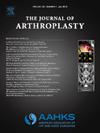Total Knee Arthroplasty Periprosthetic Joint Infection With Concomitant Extensor Mechanism Disruption and Soft-Tissue Defect: The Knee Arthroplasty Terrible Triad
IF 3.4
2区 医学
Q1 ORTHOPEDICS
引用次数: 0
Abstract
Background
Periprosthetic infection (PJI) with concomitant extensor mechanism disruption (EMD) and soft-tissue defect—hereinafter termed the “Terrible Triad”—is a devastating complication following total knee arthroplasty. The purpose of this study was to define the surgical and clinical outcomes following management of a cohort of patients who have the Terrible Triad.
Methods
From 2000 to 2022, 127 patients underwent operative management for PJI alone, 25 for PJI with soft-tissue defects (defined as defects requiring flap reconstruction or being a factor contributing to the decision of performing above-knee amputation or arthrodesis), 14 for PJI with EMD, and 22 for the Terrible Triad. A composite outcome of infection status, range of motion, extensor lag, and ambulatory status at final follow-up was used to compare the proportion of patients in each group with a favorable overall knee outcome. Differences between groups were determined using one-way analyses of variance with post hoc Tukey’s tests and Pearson’s Chi-square tests or Fisher’s exact tests with post hoc Bonferroni adjustments, where applicable. Odds ratios (OR) were calculated for comparison of the overall knee outcome between groups. A Kaplan-Meier survival analysis for patient mortality was performed.
Results
The mean follow-up was 8.4 years and similar between groups (P = .064). Patients who had the Terrible Triad had a 45.5% incidence of above-knee amputation, or arthrodesis, and an 86.4% incidence of an unfavorable outcome. Compared to patients in the PJI group, patients in the PJI who had a soft-tissue defect (OR = 5.8, 95% CI [confidence interval] 2.2 to 15.7), PJI with EMD (OR = 3.7, 95%CI 1.0 to 12.9), and Terrible Triad groups (OR = 11.6, 95% CI 3.3 to 41.5) showed higher odds of an unfavorable knee outcome.
Conclusions
This study demonstrates that the total knee arthroplasty Terrible Triad is a dreaded diagnosis with poor outcomes. Clinicians and patients might consider early treatment with amputation or arthrodesis.
Level of Evidence
III.
全膝关节置换术假体周围关节感染,同时伴有外展机制破坏和软组织缺损:膝关节置换术的可怕三重奏。
背景:假体周围感染(PJI)同时伴有伸肌机制破坏(EMD)和软组织缺损--以下称为 "可怕的三联症"--是全膝关节置换术(TKA)后的一种破坏性并发症。本研究的目的是确定一组患有 "可怕三联症 "患者的手术和临床治疗效果:从2000年到2022年,127名患者接受了单纯PJI手术治疗,25名患者接受了伴有软组织缺损的PJI手术治疗(定义为需要皮瓣重建的缺损或导致决定进行膝上截肢(AKA)或关节置换术的因素),14名患者接受了伴有EMD的PJI手术治疗,22名患者接受了可怕的三联症手术治疗。最终随访时,感染状况、活动范围、伸肌滞后和活动状况的综合结果用于比较各组中膝关节总体结果良好的患者比例。组间差异采用单因素方差分析,并进行事后Tukey's检验、Pearson's Chi-square检验或Fisher's精确检验,并酌情进行事后Bonferroni调整。在比较不同组间的膝关节总体结果时,会计算出比率(OR)。对患者死亡率进行了卡普兰-米尔生存分析:结果:平均随访时间为 8.4 年,组间结果相似(P = 0.064)。出现 "可怕三联征 "的患者中,AKA或关节置换术的发生率为45.5%,不良预后的发生率为86.4%。与PJI组患者相比,有软组织缺损的PJI组(OR=5.8,95%CI[置信区间]2.2至15.7)、有EMD的PJI组(OR=3.7,95%CI 1.0至12.9)和Terrible Triad组(OR=11.6,95%CI 3.3至41.5)患者出现不利膝关节结果的几率更高:本研究表明,TKA可怕三联征是一种可怕的诊断,其预后很差。临床医生和患者可考虑尽早截肢或关节置换术。
本文章由计算机程序翻译,如有差异,请以英文原文为准。
求助全文
约1分钟内获得全文
求助全文
来源期刊

Journal of Arthroplasty
医学-整形外科
CiteScore
7.00
自引率
20.00%
发文量
734
审稿时长
48 days
期刊介绍:
The Journal of Arthroplasty brings together the clinical and scientific foundations for joint replacement. This peer-reviewed journal publishes original research and manuscripts of the highest quality from all areas relating to joint replacement or the treatment of its complications, including those dealing with clinical series and experience, prosthetic design, biomechanics, biomaterials, metallurgy, biologic response to arthroplasty materials in vivo and in vitro.
 求助内容:
求助内容: 应助结果提醒方式:
应助结果提醒方式:


